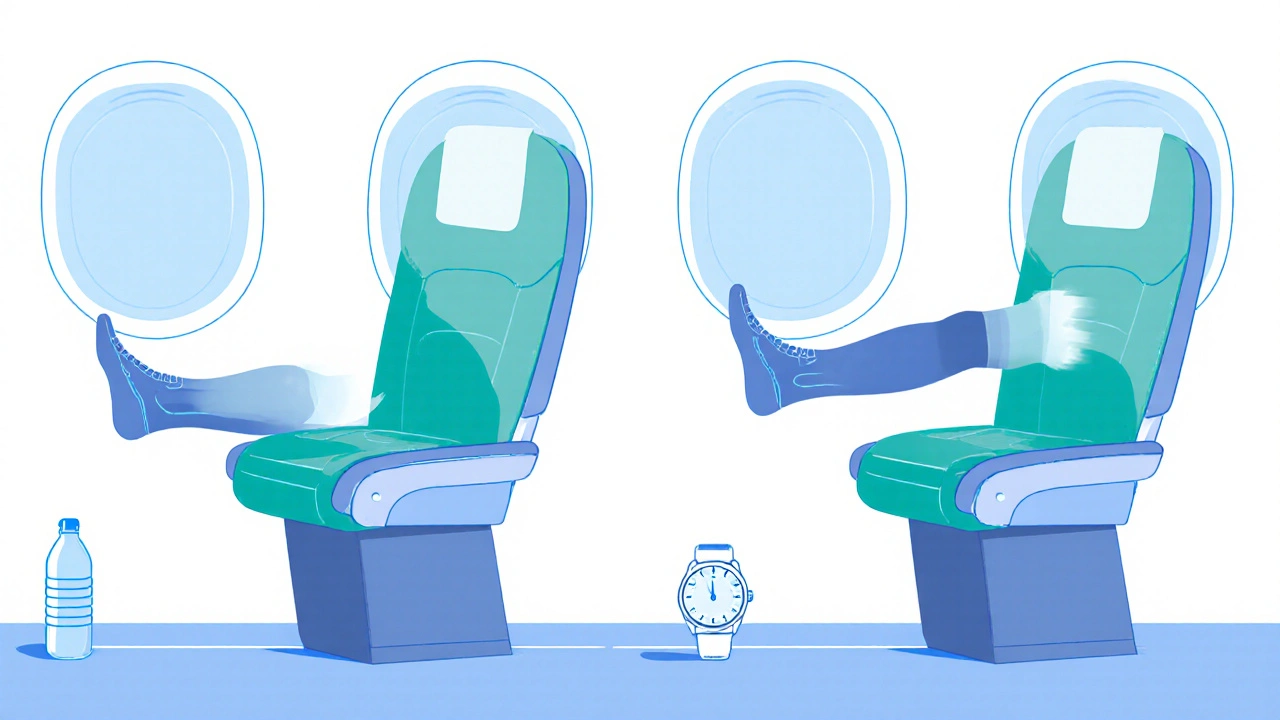DVT Prevention Risk Calculator
Assess Your DVT Risk
Answer these questions to calculate your personal risk level for deep vein thrombosis during long flights
Quick Takeaways
- Move your legs every hour - simple stretches work wonders.
- Wear graduated compression stockings for added circulation support.
- Drink water regularly; avoid excess alcohol and caffeine.
- Pick an aisle seat or ask for a seat‑change to stand up more easily.
- If you have prior clotting issues, get a quick pre‑flight medical check.
When you’re booked on a long‑haul flight (typically a journey over four hours), the risk of deep vein thrombosisa blood clot that forms in the deep veins, usually in the legs, and can travel to the lungs climbs because you sit still for many hours. If you’re worried about deep vein thrombosis, follow these steps to keep the blood moving and lower the chance of a clot forming during your trip.
Why Flights Increase DVT Risk
Air cabin environments combine three main culprits:
- Immobility: Seats are narrow, and legroom is limited, so you tend to stay in one position.
- Dehydration: Cabin air is dry, and many travelers sip sugary drinks or alcohol, which draws fluid out of the bloodstream.
- Reduced cabin pressure: Lower oxygen levels cause veins to narrow, making blood flow slower.
These factors raise the chance that blood will pool in the lower legs, forming a clot. People with a history of clotting, recent surgery, or certain genetic conditions are especially vulnerable.

Key Prevention Strategies
Below are the most effective, evidence‑backed actions you can take before and during the flight.
1. Leg Exercises and Stretching
Simple movements keep circulation active. Try these every hour:
- Heel lifts - rise onto your toes, hold for three seconds, then lower.
- Foot circles - rotate each foot clockwise, then counter‑clockwise.
- Knee extensions - straighten each leg out and hold briefly.
- Ankle pumps - point toes upward then downward.
These exercises qualify as leg exerciseslow‑impact movements designed to stimulate calf muscle pump, which is the body’s natural way to push blood up from the legs.
2. Compression Stockings
Graduated compression stockings apply gentle pressure, narrowing at the ankle and loosening toward the thigh. This gradient assists venous return.
Choose stockings with 15‑30 mmHg compression for most travelers; higher pressures are reserved for medical advice.
Compression stockingselastic hosiery that provides graduated pressure to improve leg circulation are lightweight, easy to pack, and can be worn throughout the flight without discomfort.
3. Hydration and Smart Beverage Choices
Drink at least 8‑10 ounces of water every hour. Avoid alcohol and limit caffeine, both of which can dehydrate you.
Water helps maintain blood volume, reducing the tendency for blood to thicken. If you need a flavor boost, squeeze a slice of lemon or add a splash of natural juice.
The practice of staying well‑hydrated is a cornerstone of hydrationmaintaining optimal fluid balance for circulatory health during travel.
4. Choose an Aisle Seat or Request Seat Mobility
Seats next to the aisle let you stand up to stretch without climbing over other passengers.
If you have a medical condition, ask the airline for a seat with extra legroom (often labeled “extra‑wide” or “bulkhead”).
Choosing an aisle seata seat located next to the airplane aisle, allowing easier access to the restroom and ability to stand is a simple way to increase movement opportunities.
5. Pre‑Flight Medical Check‑Up (If Needed)
People with a history of DVT, recent surgery, or clotting disorders should consult a doctor before traveling.
A clinician may recommend low‑dose anticoagulants or advise on the best compression level.
This precaution is often referred to as a pre‑flight medical checka brief health assessment to identify clotting risk before long‑distance travel.
Building Your Personal Flight‑Day DVT Prevention Plan
Use the checklist below to prepare the day before, during the flight, and after you land.
- Day before:
- Pack a pair of compression stockings (if you have them).
- Fill a reusable water bottle.
- Print or download a short exercise guide.
- At the airport:
- Walk to the gate instead of waiting in one spot.
- Do a quick set of ankle pumps while standing in line.
- During the flight (hourly):
- Drink 8‑10oz of water.
- Perform the leg‑exercise routine (about 2minutes).
- Stand up and walk the aisle if safe to do so.
- Landing and after:
- Continue walking for at least 10minutes before sitting down.
- Stretch calves and hamstrings.
- Monitor for swelling, pain, or redness in the legs for the next 48hours.
Comparison of Common DVT Prevention Tools
| Method | Effectiveness | Ease of Use | Cost | Recommended For |
|---|---|---|---|---|
| Leg exercises | High (keeps blood moving) | Very easy - no gear needed | Free | All travelers |
| Compression stockings | High (adds external pressure) | Easy - just wear them | $$ (AUD30‑80) | Those with prior DVT or limited mobility |
| Hydration (water) | Medium‑high (prevents blood thickening) | Easy - drink regularly | Free‑low | Everyone |
| Aisle seat / extra‑legroom | Medium (allows standing) | Moderate - may cost extra | $$$ (depends on airline) | Long‑haul flights, tall passengers |
| Medical prophylaxis (anticoagulants) | Very high (clinical protection) | Requires prescription | $$$ (depends on insurance) | High‑risk patients |

Common Mistakes to Avoid
Even well‑intentioned travelers slip up. Watch out for these pitfalls:
- Skipping movement because you’re engrossed in a movie - set a timer to remind yourself.
- Choosing tight clothing that restricts leg blood flow.
- Drinking only soda or coffee - sugary drinks increase dehydration risk.
- Wearing the wrong compression level - too low offers little benefit; too high can cause discomfort.
When to Seek Medical Help
If you notice any of these symptoms within 48hours after landing, contact a healthcare professional immediately:
- Sudden swelling or warmth in one leg.
- Pain that feels like cramping or a deep ache.
- Red or discolored skin.
- Shortness of breath, chest pain, or coughing up blood - signs of a possible pulmonary embolism.
Early treatment can prevent serious complications.
Frequently Asked Questions
How often should I do leg exercises on a 12‑hour flight?
Aim for a quick set every 60‑90 minutes. Each set takes about two minutes and includes heel lifts, ankle pumps, and knee extensions.
Can I wear regular socks instead of compression stockings?
Regular socks don’t provide the graduated pressure needed to aid venous return. Only stockings specifically designed for compression will give the preventive benefit.
Is it safe to take aspirin before a flight to prevent clots?
Aspirin can thin blood slightly, but it’s not a substitute for prescribed anticoagulants. Talk to your doctor before using any medication for clot prevention.
Do children need the same DVT precautions?
Kids have a lower baseline risk, but long trips still call for regular movement and hydration. Compression socks designed for children can be helpful if they have a medical condition.
What if I can’t stand up because the seatbelt sign is on?
Do seated leg exercises and ankle pumps until the sign turns off. Once it’s safe, stand and walk a few steps down the aisle.


19 Comments
Wow you think a fun web calculator will stop DVT?? 😂
Honestly staying hydrated is key on a 10‑hour flight.
I always bring a big water bottle and sip every 30 minutues.
Moving your legs in a seated position helps keep blood flowing – try ankle circles or standing up if you can.
Also avoid tight shoes; a snug fit can restrict circulation.
The physiological rationale behind calf muscle activation during flight is well documented. When you flex the gastrocnemius, venous return improves, reducing stasis. Therefore, systematic ankle dorsiflexion every hour is advisable. Additionally, moderate alcohol consumption can exacerbate dehydration, so limit intake. 🙂
Honestly, most of us just wing it and hope for the best.
From a clinical perspective, compression stockings of 15–30 mmHg have been shown to lower incidence of DVT in prolonged travel. It is advisable to don them prior to boarding and keep them on for the duration of the journey. For passengers with known risk factors, consulting a physician before travel is prudent.
Yo fam remember to stretch those calves every now and then
take a walk down the aisle if you can it helps a lot
and drink water not just coffee keep hydrated
Long flights can be a perfect storm for blood clots forming in the deep veins of the legs, especially if you sit still for hours on end. The main culprit is venous stasis, where blood pools because your muscles aren't contracting to push it back toward the heart. To counteract this, simple leg exercises can make a huge difference; think ankle circles, calf raises, and toe wiggles. Even standing up and taking a quick stroll down the aisle every hour can break up the stagnation. Compression stockings are another powerful tool – they apply gentle pressure that encourages blood flow and are especially helpful for those with a personal or family history of clotting. Choose a pair that offers 15‑30 mmHg graduated compression and wear them snugly but comfortably. Hydration plays a pivotal role as well; water thins the blood slightly, making it less likely to clot, whereas alcohol and caffeine can dehydrate you and increase viscosity. Aim to sip at least two liters of water over the course of a ten‑hour flight, and avoid sugary drinks that can cause spikes in blood sugar. Your seat choice matters too – an aisle seat makes it easier to get up without disturbing neighbors, and you can stretch your legs more freely. If you have a genetic clotting disorder, recent surgery, or a previous DVT, you should absolutely talk to your doctor before you board – they may prescribe a low‑dose anticoagulant or other preventative measures. Even a short walk in the terminal before boarding can get your circulation going, priming your muscles for the journey ahead. Pack a small bottle of hand sanitizer and keep your hands clean; infections can indirectly increase clot risk by triggering inflammation. Remember to avoid crossing your legs tightly, as that compresses veins and hampers flow. Keep your feet flat on the floor rather than perched on the seat belt or on the tray table. If you feel any unusual swelling, pain, or a heavy sensation in your calf, it’s wise to alert the flight crew and seek medical evaluation as soon as you land. Finally, adopt a mindset that views these small actions – moving, drinking, compressing – as an investment in your health, not a hassle, and you’ll arrive at your destination feeling fresher and safer.
Great points so far. I’d add that checking the seat pitch before booking can help you find a little extra legroom, which makes those calf raises easier. Also, a quick glance at your airline’s health advisory page might reveal if they provide complimentary compression socks.
In the grand scheme of transatlantic travel, the elite among us understand that preventive measures are non‑negotiable. One must don calibrated compression stockings, sip filtered water, and engage in systematic calf mobilization. Anything less reeks of complacency unworthy of a seasoned globetrotter. Moreover, the American spirit thrives on proactive health; we do not simply endure the odds.
Everyone talks about DVT like it’s just a medical footnote, but what if airlines are hiding the real risk? They push sugary drinks and tiny pretzels that increase clotting potential. Stay vigilant, bring your own water, and don’t trust the cabin crew’s “just stretch a bit” advice.
Honestly this whole DVT spiel is overblown, but if you must obsess, here’s the rundown: first, buy compression socks that actually fit or else they’ll just cut off circulation – pointless. second, avoid alcohol like the plague because it dehydrates you and makes your blood thicker, which some claim increases clot risk but I think it’s just marketing hype. third, set a timer on your phone every 45 minutes to remind you to get up, do ankle circles, and maybe walk down the aisle if you’re lucky enough to have an open seat. fourth, keep a water bottle within arm’s reach; if you forget to drink, you’ll be thirsty and cranky – not a good combo for any health concern. fifth, if you have any pre‑existing condition, see a doctor, though most doctors just hand you a prescription and a brochure. Finally, don’t let the airline’s bland lighting and cramped seats ruin your vibe; bring some noise‑cancelling headphones and a good book, and you’ll forget you’re even on a plane. That’s it.
I love the idea of a quick risk calculator but wonder if it accounts for age and weight. Those factors can really change the odds. Also, do most airlines sell compression socks on board? If not, it’d be great to know where to grab a pair before boarding.
Check your flight duration and set a timer for leg stretches keep a water bottle handy and wear compression socks if you’re at risk
Hey everyone! Keep that positive vibe – a little movement, a sip of water, and a comfy pair of compression socks can make any long haul feel like a breeze. You’ve got this!
OMG the drama of trying to get up on a packed flight is real! But trust me, those quick calf squeezes are like a mini‑dance party for your legs – totally worth the applause from fellow travelers.
This “simple tip” thing is nonsense. Most people ignore it and end up with swollen calves. The data shows a 30% increase in clot incidents on flights where passengers didn’t follow any protocol. Wake up and do something.
I totally agree with the earlier advice – moving, hydrating, and wearing compression gear are the holy trinity of DVT prevention. Let’s keep sharing tips and support each other on those marathon flights.
Our nation’s travelers must exemplify vigilance; neglecting DVT prevention reflects poorly on our collective discipline. Adhere to the guidelines, or risk undermining the reputation of our people on the world stage.
Just a heads‑up – double‑check the sizing chart for compression socks, otherwise they’ll be too tight and actually hurt.